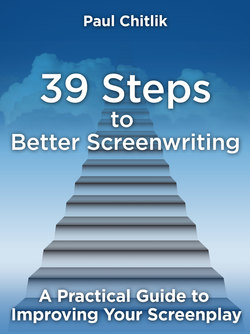Читать книгу 39 Steps to Better Screenwriting - Paul Chitlik - Страница 10
На сайте Литреса книга снята с продажи.
ОглавлениеStep 4
“An Original Screenplay By”
I often see this on title pages of scripts by my students: “An Original Screenplay by.” It’s the standard credit that some screenplay programs include with their title pages, but it’s meaningless. First of all, it’s not an official Writers Guild of America credit which, for an original screenplay, is limited to two choices: “Written by,” or, simply, “by.”
Of course, credits for screenplays which are adaptations or include other writers working on the project (say, for example, someone else wrote the story) are different. But if you, the writer, came up with the idea, wrote the story (or skipped directly to the screenplay) , then wrote the screenplay, then, of course, it’s an original screenplay. What else could it be?
Then what does it mean when you see the credit that says, “Screenplay by”? This can mean a couple of things. One, that someone else wrote the story or that the writer shared story credit, in which case the credit is separated to indicate same. It could also mean that the screenwriter based her screenplay on an existing work or previous release in a franchise. For example, if a writer adapted a book, say A Tale of Two Cities, then the credit would be, first, “Based on A Tale of Two Cities” by Charles Dickens, followed by a separate card saying, “Screenplay by John Doe.”
This applies to sequels, too, even though the screenplay may be a prequel or may not really continue the story, or even may not have anything to do with the original film except using the same set of characters. This designation happened in films nominated for Oscars from 2013 when Richard Linklater, Ethan Hawke, and Julie Delpy’s screenplay for Before Midnight was placed in the best adapted screenplay category because it was based on characters from their previous two collaborations. It was an entirely original work, yet it was considered an adaptation.
Is this fair? I think so. The hard work of writing a screenplay consists of two things — creating characters and creating a world (a story) in which they develop. If part of the work is done previously, then your job as a screenwriter is easier. Oh, yes, you still go through torture crafting your story, selecting the right scenes and the right characters, adding or subtracting from the story, even inserting your own story into it (see Adaptation, written by Charlie Kaufman, 2002, for an example of this). But the fact is, much work has been done for you (or even by you) by the originator of the story or characters. Yes, you still sit in front of a blank screen, but you have a starting place. If you’re writing an original work, you have nothing but your own imagination to give you the impetus to start typing.
That’s one reason more adaptations find their way to the screen than originals. (There are others — name recognition, sequels, previous success of the material, etc.) Given this fact, though, why is adaptation not focused on in most film schools (Where I teach — Loyola Marymount University — there is a specific adaptation class. Where I have taught before — UCLA — there is not.) The easy answer is that schools want to focus on the process: creating characters, constructing stories, writing scenes. In other words, making an “original screenplay.” And that may be why “An original screenplay by” is included in screenwriting programs, which have their greatest distribution in film schools. But, in truth, every story is “original” even if it’s based on work previously done. Just ask Shakespeare, who based many of his plays on previous works, or Marc Norman and Tom Stoppard, whose Shakespeare in Love borrowed much from Shakespeare (and invented much more).
